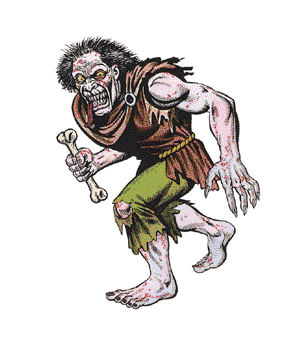

2140

| Ghoul | Lacedon | Ghast | |
|---|---|---|---|
| Climate/Terrain: | Any land | Any water | Any land |
| Frequency: | Uncommon | Very rare | Rare |
| Organization: | Pack | Pack | Pack |
| Activity Cycle: | Night | Night | Night |
| Diet: | Corpses | Corpses | Corpses |
| Intelligence: | Low (5-7) | Low (5-7) | Very (11-12) |
| Treasure: | B,T | B,T | B,Q,R,S,T |
| Alignment: | Chaotic evil | Chaotic evil | Chaotic evil |
| No. Appearing: | 2-24 (2d12) | 2-24 (2d12) | 1-6 or 1-4 (with Ghoul packs) |
| Armor Class: | 6 | 6 | 4 |
| Movement: | 9 | Sw 9 | 15 |
| Hit Dice: | 2 | 2 | 4 |
| THAC0: | 19 | 19 | 17 |
| No. of Attacks: | 3 | 3 | 3 |
| Damage/Attack: | 1-3/1-3/1-6 | 1-3/1-3/1-6 | 1-4/1-4/1-8 |
| Special Attacks: | Paralyzation | Paralyzation | See below |
| Special Defenses: | See below | See below | See below |
| Magic Resistance: | Nil | Nil | Nil |
| Size: | M (5-6’ tall) | M (5-6’ tall) | M (5-6’ tall) |
| Morale: | Steady (11-12) | Steady (11-12) | Elite (13-14) |
| XP Value: | 175 | 175 | 650 |
Ghouls are undead creatures, once human, who now feed on the flesh of corpses. Although the change from human to ghoul has deranged and destroyed their minds, ghouls have a terrible cunning which enables them to hunt their prey most effectively.
Ghouls are vaguely recognizable as once having been human, but have become horribly disfigured by their change to ghouls. The tongue becomes long and tough for licking marrow from cracked bones, the teeth become sharp and elongated, and the nails grow strong and sharp like claws.
Combat: Ghouls attack by clawing with their filthy nails and biting with their fangs. Their touch causes humans (including dwarves, gnomes, half-elves, and halflings, but excluding elves) to become rigid unless a saving throw versus paralyzation is successful. This paralysis lasts for 3-8 (2+1d6) rounds or until negated by a priest.
Any human or demi-human (except elves) killed by a ghoulish attack will become a ghoul unless blessed (or blessed and then resurrected). Obviously, this is also avoided if the victim is devoured by the ghouls. Ghoul packs always attack without fear.
These creatures are subject to all attack forms except sleep and charm spells. They can be turned by priests of any level. The magic circle of protection from evil actually keeps ghouls completely at bay.
Habitat/Society: Ghouls and ghasts are most frequently encountered around graveyards, where they can find plenty of corpses on which to feed.
Ecology: Ghouls (and ghasts, as described later) delight in revolting and loathsome things — from which we draw our adjectives “ghoulish” and “ghastly”.
Lacedon
The lacedon is a marine form of the ghoul. Lacedons are sometimes found near marine ghosts, particularly ghost ships. Lacedons are less common than ghouls because of the fewer corpses available for them to feed on, but they can often be found swarming around recent shipwrecks in rivers, lakes, and oceans.
Ghast
These creatures are so like ghouls as to be completely indistinguishable from them, and they are usually found only with a pack of ghouls. When a pack of ghouls and ghasts attacks it will quickly become evident that ghasts are present, for they exude a carrion stench in a 10’ radius which causes retching and nausea unless a saving throw versus poison is made. Those failing to make this save will attack at a penalty of -2.
Worse, the ghast shares the ghoulish ability to paralyzation, and their attack is so potent that it will even affect elves. Paralysis caused by a ghast lasts for 5-10 (4+1d6) rounds or until negated by a priest’s remove paralysis spell.
Ghasts, like ghouls, are undead class and thus sleep and charm spells do not affect them. Though they can be struck by any sort of weapon, cold iron inflicts double normal damage. Clerics can turn them beginning at 2nd level. The circle of protection from evil does not keep them at bay unless it is used in conjunction with cold iron (such as a circle of powdered iron or an iron ring).

◆ 789 ◆